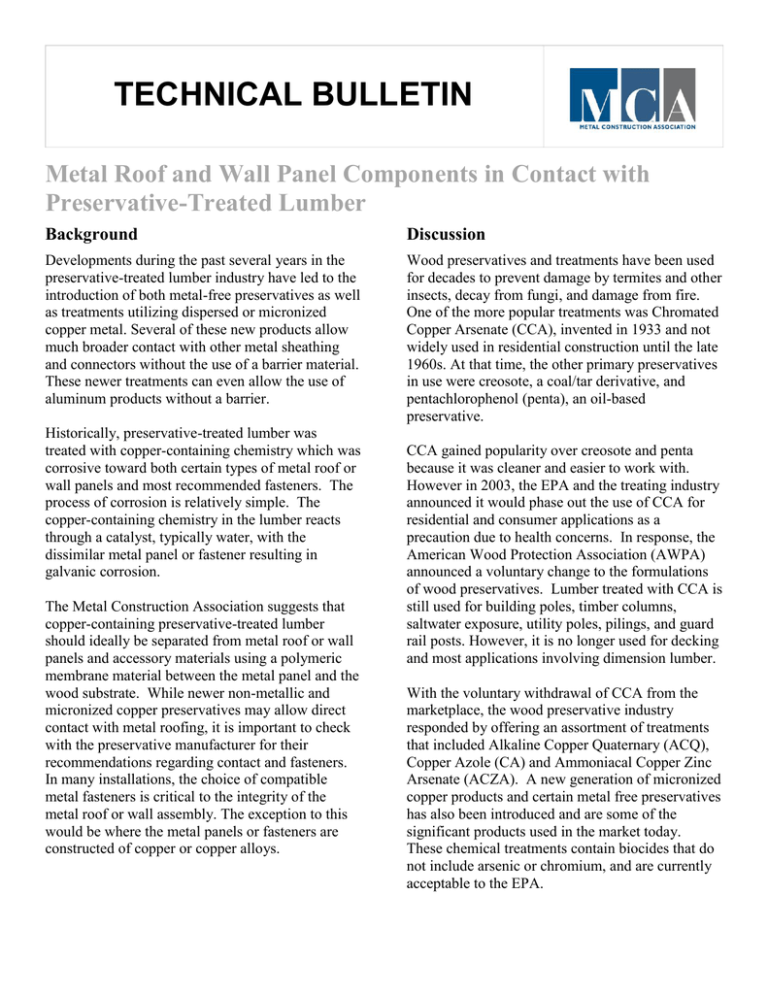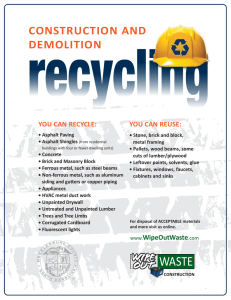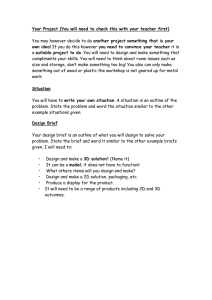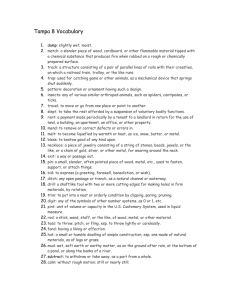
TECHNICAL BULLETIN
Metal Roof and Wall Panel Components in Contact with
Preservative-Treated Lumber
Background
Discussion
Developments during the past several years in the
preservative-treated lumber industry have led to the
introduction of both metal-free preservatives as well
as treatments utilizing dispersed or micronized
copper metal. Several of these new products allow
much broader contact with other metal sheathing
and connectors without the use of a barrier material.
These newer treatments can even allow the use of
aluminum products without a barrier.
Wood preservatives and treatments have been used
for decades to prevent damage by termites and other
insects, decay from fungi, and damage from fire.
One of the more popular treatments was Chromated
Copper Arsenate (CCA), invented in 1933 and not
widely used in residential construction until the late
1960s. At that time, the other primary preservatives
in use were creosote, a coal/tar derivative, and
pentachlorophenol (penta), an oil-based
preservative.
Historically, preservative-treated lumber was
treated with copper-containing chemistry which was
corrosive toward both certain types of metal roof or
wall panels and most recommended fasteners. The
process of corrosion is relatively simple. The
copper-containing chemistry in the lumber reacts
through a catalyst, typically water, with the
dissimilar metal panel or fastener resulting in
galvanic corrosion.
The Metal Construction Association suggests that
copper-containing preservative-treated lumber
should ideally be separated from metal roof or wall
panels and accessory materials using a polymeric
membrane material between the metal panel and the
wood substrate. While newer non-metallic and
micronized copper preservatives may allow direct
contact with metal roofing, it is important to check
with the preservative manufacturer for their
recommendations regarding contact and fasteners.
In many installations, the choice of compatible
metal fasteners is critical to the integrity of the
metal roof or wall assembly. The exception to this
would be where the metal panels or fasteners are
constructed of copper or copper alloys.
CCA gained popularity over creosote and penta
because it was cleaner and easier to work with.
However in 2003, the EPA and the treating industry
announced it would phase out the use of CCA for
residential and consumer applications as a
precaution due to health concerns. In response, the
American Wood Protection Association (AWPA)
announced a voluntary change to the formulations
of wood preservatives. Lumber treated with CCA is
still used for building poles, timber columns,
saltwater exposure, utility poles, pilings, and guard
rail posts. However, it is no longer used for decking
and most applications involving dimension lumber.
With the voluntary withdrawal of CCA from the
marketplace, the wood preservative industry
responded by offering an assortment of treatments
that included Alkaline Copper Quaternary (ACQ),
Copper Azole (CA) and Ammoniacal Copper Zinc
Arsenate (ACZA). A new generation of micronized
copper products and certain metal free preservatives
has also been introduced and are some of the
significant products used in the market today.
These chemical treatments contain biocides that do
not include arsenic or chromium, and are currently
acceptable to the EPA.
The preservative treated lumber, where copper is
the main ingredient of the preservative, performed
similarly to CCA treated lumber. However, it was
soon discovered these preservatives also can be
corrosive toward metal, other than copper or copper
alloys, in situations where the lumber will be
exposed to moisture.
Corrosivity of Preservative-Treated Lumber
Corrosion of metals in an aqueous environment is
an electrochemical process involving two steps:
1) Water and oxygen, must diffuse to the metal
surface, and
2) Reactants must have enough energy to
complete the reaction.
Within preservative-treated lumber, some of the
preservative chemicals bond to the wood and a
small percentage remain in ionic form. The ionic
components increase the corrosiveness of the wood
product toward metal. At higher moisture contents,
wood conducts electricity and ions better, and
therefore, the corrosion reaction occurs at a faster
rate. It is believed that corrosion activity within
wood requires moisture content of 20% or greater.(1)
New preservative formulations such as ACQ, CA,
and MCQ contain much more copper than CCA.
Copper ions can accelerate the corrosion of steel
and aluminum.
The potential for corrosion of hardware in contact
with treated wood occurs when metals in the
preservative (such as copper) are different from the
metals in the hardware (the iron in steel, or
aluminum). In a wet environment these dissimilar
metals create a small electrical current that triggers
a chemical reaction resulting in galvanic corrosion.
This is the challenge in selecting proper fasteners
and connectors to be used with preservative treated
wood. The MCA’s Technical Bulletin on Fastener
Selection Guideline addresses this for metal panels
as follows: (2)
© 6/2014
“ACQ or CA preservative-treated lumber can be
incompatible with certain types of fasteners. In those
cases where any type of metal roof or wall cladding
materials are being attached to preservative-treated
lumber, the following fasteners are not compatible: zinc
plated screws, zinc-alloy headed screws, stainless
capped screws, aluminum, copper and copper alloy.
Metal panel fasteners that are compatible with
preservative-treated lumber are stainless steel fasteners,
or hot dip galvanized nails manufactured to ASTM A153
class D or heavier. Other types of fasteners coated with
proprietary anti-corrosive technologies may be
compatible for use with preservative-treated lumber.
Allowable use should be verified with the fastener
manufacturer.”
Industry Positions
The manufacturers of wood preservative chemicals
make specific recommendations regarding
unpainted galvanized or Galvalume sheet panels.
Generally they advise against direct, long-term
contact with wood treated with the newer copper
based preservatives such as ACQ, CA, or MCQ.
Both the International Building Code and the
International Residential Code require that stainless
steel or hot-dipped galvanized fasteners meeting
ASTM International A153 Standard Specification
for Zinc coating (Hot-Dip) on Iron and Steel
Hardware be used. Connectors must be ASTM
A653, Standard Specification for Steel Sheet, Zinccoated (Galvanized) or Zinc-Iron Alloy-coated
(Galvannealed) by the Hot-Dip Process, Class
G185 sheet or better for protection against the
effects of moisture where treated wood is used.
The manufacturers also recommend that aluminum
not be used in direct contact with preservativetreated lumber that is not treated using metal-free or
micronized copper preservatives. In these cases,
MCA suggests that metal materials, other than
copper or copper alloys, should be separated from
the treated lumber with a physical barrier that
prevents contact with the metal panels or chemicals
leaching through to the metal panels such as, but not
limited to, rubber, vinyl, plastic sheeting, asphalt
roofing paper, or a maintained industrial coating.(3)
Specific Steel Industry Recommendations
Wheeling Corrugating:
Wheeling Corrugating(a) conducted a study to
determine the effectiveness of a specific barrier in
preventing the corrosive attack between treated
lumber and metal wall panels.(4) The research was
conducted by H.L. Stauver of Touchstone Research
Laboratory, Ltd, in Triadelphia, W. VA. The
conclusion from that study was:
“Water and ice shield material was most effective in
preventing a corrosive reaction between any of the
steel products tested and either type (ACQ and
copper azole) of pressure-treated lumber.
Effectively, there was no surface damage where the
water/ice shield contacted the metal or painted
surfaces. The use of 30-pound roofing felt was
somewhat effective in minimizing the corrosion of
the various steel products, but does not appear to
offer substantial improvement over direct metal to
wood contact. Direct contact with the pressuretreated lumber grades had the anticipated effect of
corrosion on both the galvanized products and two
of the painted steel materials in that the paint and
the base steel were damaged by direct contact with
the treated lumber…it is recommended that all
galvanized be protected with water/ice shield
membrane or with a similar product in any
construction.”
prepainted Galvalume. The preservative-treated
lumber included CCA and ACQ chemicals. The
results showed that ACQ was generally more
corrosive to most coated steel products.
U.S. Steel concluded that isolating steel from
preservative-treated lumber using water resistant
barrier materials is an effective way to minimize
corrosion. The isolating products would include
peel-and-stick polymeric membranes, polymer tapes,
masking and lining materials. They also concluded
that using isolating materials with a paper or felt
component should be avoided since they can retain
moisture which can increase corrosion potential.(5)
National Frame Building Association (NFBA):
Most metal component manufacturers recommend
that panels or flashing should not come into contact
with preservative-treated lumber. Many
manufacturers recommend installing a barrier
material that will stop all electrical current between
the treated lumber and metal. Furthermore, NFBA
suggests that water should not drain off of treated
lumber onto panels or flashing.(6)
National Roofing Contractors Association (NRCA):
The NRCA recognizes the lack of long-term
corrosion performance data on newer preservativetreated lumber such as ACQ, CA, MCQ in contact
with metal fasteners, panels and flashing. Their
guidelines include the following:
(a)
Wheeling Corrugating is no longer involved in
the manufacture of roof sheathing materials.
U.S. Steel:
U. S. Steel tested preservative-treated lumber in
contact with their architectural sheet steel products
commonly used for metal roofing and siding
applications. Products included G90, Galvalume,
acrylic-coated Galvalume, prepainted HDG, and
© 6/2014
“Aluminum fasteners, flashings and accessory
products should not be used in direct contact
with any treated wood. ACQ-treated wood is not
compatible with aluminum.
Uncoated metal and painted metal flashings and
accessories, except for 300-series stainless steel,
should not be used in direct contact with treated
wood. Metal products, except stainless steel,
may be used if separated from treated wood by
a spacer or barrier, such as single-ply
membrane or self-adhered polymer-modified
bitumen membrane material.” (7)
NRCA also states … “NRCA is of the opinion that
the corrosion-related concerns regarding the use of
currently available treated wood possibly outweigh
the benefits that treated wood provides as a
component in roof assemblies. In many instances,
non-treated, construction- grade wood is suitable
for use in roof assemblies as blocking or nailers,
provided reasonable measures are taken to ensure
the nontreated wood remains reasonably dry when
in service. Where a specific construction detail
provides for a secondary means of waterproofing,
NRCA now considers the use of nontreated,
construction-grade wood to be an acceptable
substitute for treated wood.” (7)
Steel Deck Institute:
The SDI conducted tests of G60, G90, and primed
steel deck in contact with ACQ and Copper Azole
preservative-treated lumber. They also evaluated the
performance with a barrier between the pressure
(preservative) treated lumber and the steel
specimens. The barriers were 30 pound felt paper
and water/ice shield. Using the AWPA procedure
E12 “Standard Method for Determining Corrosion
of Metal in Contact with Treated Wood”, the SDI
found the following:
“The results of this study found that the use of
water and ice shield material was most effective in
preventing a corrosive reaction between any of the
steel products tested and either type of pressure
treated lumber. Effectively, there was no surface
damage where the water/ice shield contacted the
metal or painted surfaces. The use of 30 pound
roofing felt was somewhat effective in minimizing
the corrosion of the various steel products, but does
not appear to offer substantial improvement over
direct metal to wood contact. Direct contact with
the pressure treated lumber grades had the
anticipated effect of corrosion on both the
galvanized products and the painted steel materials
© 6/2014
in that the zinc coating and/or the paint and the
base steel were damage by direct contact with the
treated lumber.” (8)
As a result, the Steel Deck Institute recommends a
barrier of water-and-ice shield or equivalent be used
between pressure treated lumber and steel deck
products or accessories.
Summary
Based on the information and testing experience
gathered from a variety of sources, it is clear that
the use of any of the commercially available
copper-containing preservative-treated lumber in
direct contact with certain metal products could lead
to accelerated corrosion and affect the long-term
integrity and performance of a metal roof or wall
system. The most effective way to avoid corrosion
is to ensure that the treated lumber used is either
manufactured using the newer metal-free
preservatives, micronized copper treatment or that
there is a separation between the metal roof or wall
panel and the pressure (preservative) treated wood
with some type of barrier material. (The
preservative-treated lumber manufacturer should
always be contacted to verify that the material may
be used in contact with the intended metal
components.)
The Metal Construction Association suggests
that, unless specifically treated with metal-free
preservatives or some of the newer technologies,
copper-containing preservative-treated lumber
should be separated from metal roof or wall
panels and accessory materials by a barrier
membrane material between the metal panel and
the wood substrate. In those installations, the
choice of compatible metal fasteners is also
critical to the integrity of the metal roof or wall
assembly.
The Metal Construction Association will continue
to monitor the recommendations from the wood
preservative industry before and inform the market
as further developments are made and validated.
References
(1) Flynn,K., Quarles, S., and Shelly, Jl, NonBiological Deterioration of Wood, Forest
Products Laboratory, University of California,
1995.
(2) Fastener Selection Guideline, Metal
Construction Association Technical Bulletin,
May 2008.
(3) H. DeVenzio, Treated Wood, The Construction
Specifier, May 2005.
(4) Tests Shed Light on Corrosion, Rural Builder,
May 2005.
(5) ACQ Pressure Treated Lumber Effect on Sheet
Steel, United States Steel Corporation Technical
Bulletin, TBP 2005.19.
(6) Pressure-Treated Wood for Post-Frame
Construction, published by the National Frame
Building Association.
(7) The NRCA Roofing Manual: Architectural
Metal Flashing, Condensation and Air Leakage
Control, and Reroofing published by the
National Roofing Contractors Association, 2014.
(8) Steel Deck Products in Contact with Pressure
Treated Lumber, Steel Deck Institute Position
Statement, August 2006.
Founded in 1983, the Metal Construction
Association brings together the diverse metal
construction industry for the purpose of expanding
the use of all metals used in construction. MCA
promotes the benefits of metal in construction
through:
• Technical guidance
• Product certification
• Educational and awareness programs
• Advocating for the interests of our industry
• Recognition of industry-achievement awards
© 6/2014
• Monitoring of industry issues, such as codes and
standards
• Research to develop improved metal construction
products
• Promotional and marketing support for the metal
construction industry
• Publications to promote use of metal wall and roof
products in construction
For more information, please visit the MCA Web
site at www.metalconstruction.org
Copyright © 2014 Metal Construction Association.
All rights reserved.
No part of this publication may be reproduced in
any form or by any means, including photocopying,
or utilized by any information storage or retrieval
system without permission of the copyright owner.
This bulletin is for general information only. The
bulletin is designed to delineate areas requiring
consideration. Information contained in the bulletin
should not be used without first securing competent
advice with respect to its suitability for any given
application. MCA does not assume responsibility
and disclaims any representation or warranty,
express or implied, that such information is suitable
for any general or particular use. Anyone making
use of the bulletin assumes all liability resulting
from such use.
The existence of the bulletin does not in any respect
preclude a member or nonmember of MCA from
manufacturing, selling, or specifying products not
conforming to the bulletin, nor does the existence of
an MCA bulletin preclude its voluntary use by
persons other than MCA members. The bulletin
does not purport to address all safety problems
associated with its use or all applicable regulatory
requirements. It is the responsibility of the user of
the guideline to establish appropriate safety and
health practices and to determine the applicability
of regulatory limitations before use of the bulletin.
The Metal Construction Association reserves the
right to change, revise, add to, or delete any data
contained in the bulletin without prior notice.
It is the responsibility of the end user to verify the
applicability of this information with the local
building and fire officials.
© 6/2014






